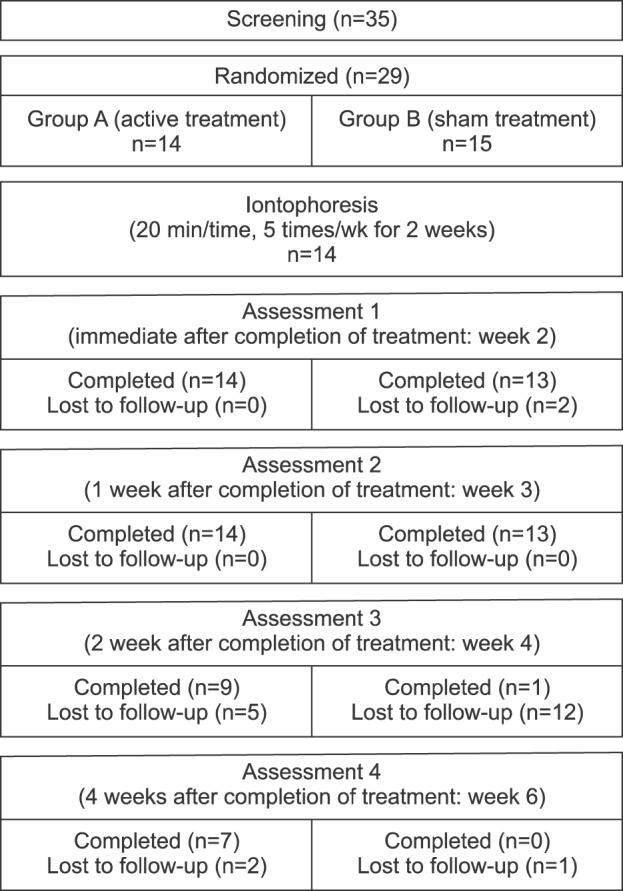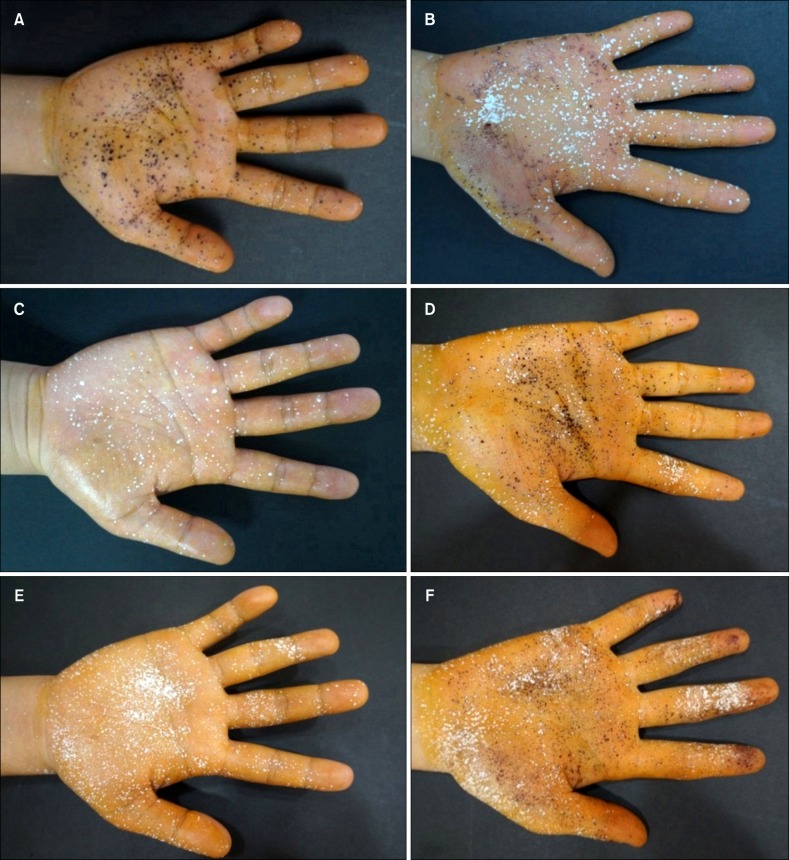Ann Dermatol.
2017 Dec;29(6):728-734. 10.5021/ad.2017.29.6.728.
Treatment of Palmar Hyperhidrosis with Tap Water Iontophoresis: A Randomized, Sham-Controlled, Single-Blind, and Parallel-Designed Clinical Trial
- Affiliations
-
- 1Department of Dermatology, Dongguk University Ilsan Hospital, Goyang, Korea. lay5604@naver.com
- KMID: 2395180
- DOI: http://doi.org/10.5021/ad.2017.29.6.728
Abstract
- BACKGROUND
Palmar hyperhidrosis is a common disorder of excessive sweating. A number of studies have demonstrated the effectiveness of iontophoresis in the treatment of palmar hyperhidrosis. However, controlled clinical studies on iontophoresis for palmar hyperhidrosis have been limited.
OBJECTIVE
To determine the efficacy and safety of iontophoresis in the treatment of palmar hyperhidrosis with a randomized, sham-controlled, single-blind, and parallel-designed study.
METHODS
Twenty nine patients with significant palmar hyperhidrosis were enrolled in this study. They received active iontophoresis treatment (group A) or sham treatment (group B). Iontophoresis was performed 20 minutes each time, five times per week, for 2 weeks. Its efficacy was assessed with starch-iodine test, mean sweat secretion rate, and hyperhidrosis disease severity scale.
RESULTS
Twenty-seven of the 29 patients completed the 2-week treatment. After completion of 10 times of treatment, results of the starch-iodine test showed clinical improvement in 92.9% of patients in group A and 38.5% of patients in group B (p=0.001). The mean sweat secretion rate was reduced by 91.8% of patients in group A and by 39.1% of patients in group B (p<0.001). Improvement in quality of life was reported by 78.6% of patients in group A and by 30.8% of patients in group B (p=0.028). In group A, one case of localized adverse event was noted, although no adverse event was encountered in group B.
CONCLUSION
Tap water iontophoresis could be used as an effective and safe treatment modality for palmar hyperhidrosis.
Keyword
MeSH Terms
Figure
Reference
-
1. Callejas MA, Grimalt R, Cladellas E. Hyperhydrosis update. Actas Dermosifiliogr. 2010; 101:110–118. PMID: 20223153.2. Schlereth T, Dieterich M, Birklein F. Hyperhidrosis--causes and treatment of enhanced sweating. Dtsch Arztebl Int. 2009; 106:32–37. PMID: 19564960.3. Vorkamp T, Foo FJ, Khan S, Schmitto JD, Wilson P. Hyperhidrosis: evolving concepts and a comprehensive review. Surgeon. 2010; 8:287–292. PMID: 20709287.
Article4. Solish N, Bertucci V, Dansereau A, Hong HC, Lynde C, Lupin M, et al. A comprehensive approach to the recognition, diagnosis, and severity-based treatment of focal hyperhidrosis: recommendations of the Canadian Hyperhidrosis Advisory Committee. Dermatol Surg. 2007; 33:908–923. PMID: 17661933.
Article5. Kurta AO, Glaser DA. Emerging nonsurgical treatments for hyperhidrosis. Thorac Surg Clin. 2016; 26:395–402. PMID: 27692197.
Article6. Kim WO, Kil HK, Yoon KB, Yoon DM. Topical glycopyrrolate for patients with facial hyperhidrosis. Br J Dermatol. 2008; 158:1094–1097. PMID: 18294315.
Article7. Walling HW, Swick BL. Treatment options for hyperhidrosis. Am J Clin Dermatol. 2011; 12:285–295. PMID: 21714579.
Article8. Fujimoto T. Pathophysiology and treatment of hyperhidrosis. Curr Probl Dermatol. 2016; 51:86–93. PMID: 27584967.
Article9. Stolman LP. Treatment of excess sweating of the palms by iontophoresis. Arch Dermatol. 1987; 123:893–896. PMID: 3606167.
Article10. Dahl JC, Glent-Madsen L. Treatment of hyperhidrosis manuum by tap water iontophoresis. Acta Derm Venereol. 1989; 69:346–348. PMID: 2568061.11. Kim YD, Jun JB. Treatment of palmoplantar hyperhidrosis with iontophoresis. Korean J Dermatol. 1990; 28:758–764.12. Chan LY, Tang WY, Mok WK, Ly CY, Ip AW. Treatment of palmar hyperhidrosis using tap water iontophoresis: local experience. Hong Kong Med J. 1999; 5:191–194. PMID: 11821591.13. Karakoç Y, Aydemir EH, Kalkan MT, Unal G. Safe control of palmoplantar hyperhidrosis with direct electrical current. Int J Dermatol. 2002; 41:602–605. PMID: 12358834.
Article14. Dogruk Kacar S, Ozuguz P, Eroglu S, Polat S, Karaca S. Treatment of primary hyperhidrosis with tap water iontophoresis in paediatric patients: a retrospective analysis. Cutan Ocul Toxicol. 2014; 33:313–316. PMID: 24405389.
Article15. Papa CM, Kligman AM. Mechanisms of eccrine anidrosis. I. High level blockade. J Invest Dermatol. 1966; 47:1–9. PMID: 25622342.16. Sato K, Timm DE, Sato F, Templeton EA, Meletiou DS, Toyomoto T, et al. Generation and transit pathway of H+ is critical for inhibition of palmar sweating by iontophoresis in water. J Appl Physiol (1985). 1993; 75:2258–2264. PMID: 8307885.
Article17. Ohshima Y, Shimizu H, Yanagishita T, Watanabe D, Tamada Y, Sugenoya J, et al. Changes in Na+, K+ concentrations in perspiration and perspiration volume with alternating current iontophoresis in palmoplantar hyperhidrosis patients. Arch Dermatol Res. 2008; 300:595–600. PMID: 18677499.
Article18. Anliker MD, Kreyden OP. Tap water iontophoresis. Curr Probl Dermatol. 2002; 30:48–56. PMID: 12471698.
Article19. Reinauer S, Neusser A, Schauf G, Hölzle E. Pulsed direct current iontophoresis as a possible new treatment for hyperhidrosis. Hautarzt. 1995; 46:543–547. PMID: 7558823.20. Bouman HD, Lentzer EM. The treatment of hyperhidrosis of hands and feet with constant current. Am J Phys Med. 1952; 31:158–169. PMID: 14943812.
- Full Text Links
- Actions
-
Cited
- CITED
-
- Close
- Share
- Similar articles
-
- Treatment of Palmoplantar Hyperhidrosis with Iontophoresis
- Treatment of idiopathic hyperhidrosis by iontophoresis
- Daily Self-Monitoring and Feedback of Circadian Rhythm Measures in Major Depression and Bipolar Disorder Using Wearable Devices and Smartphones–The Circadian Rhythm for Mood (CRM®) Trial Protocol: A Randomized Sham Controlled Double-Blind Trial
- Long-term Follow-up of Limited T3 Symathicotomy in Palmar Hyperhidrosis
- Comparative Study of 20% Aluminum Chloride Solution and Botulinum Toxin A Injection in the Treatment of Patients with Primary Palmar Hyperhidrosis



